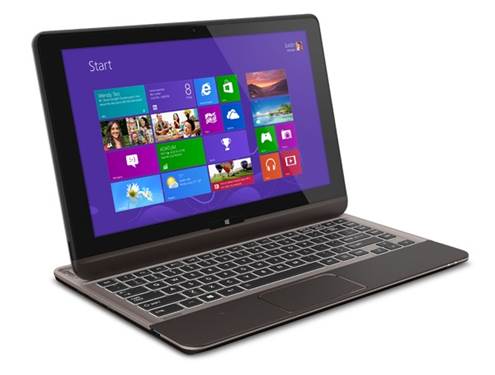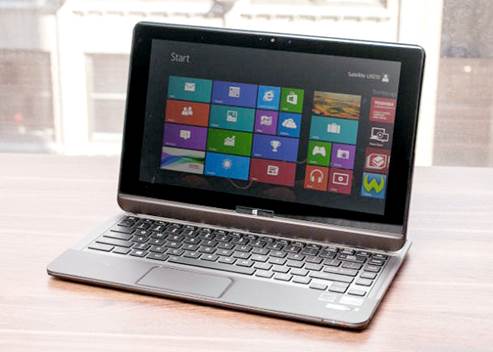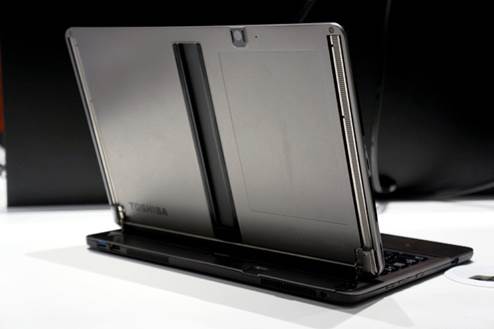With its first Windows 8 convertible,
Toshiba bets big on the slider.
You cannot see our New York City office at
this time, but it looks like a laptop menagerie. We recently completed our
review of a laptop whose screen flips in its joints, and now we are testing an
Ultrabook with the touch screen, along with a laptop whose screen folds
completely behind. The Toshiba Satellite U925t ($1,150) is another Windows 8
hardware line. Accurately, it is a type of slider, whose 12.5-inch screen
slides out and up to expose a large-size keyboard. It's nice in theory, since
you can use it as a tablet without having to worry about carrying a separate
keyboard. But unlike Dell XPS 12 or Lenovo IdeaPad Yoga 13, which can also be
used in the tablet mode, the screen here is always exposed. As you can imagine,
the screen is propped up, which has a very real impact on the typing
experience. Based on all of those, are there any reasons to consider it against
the other Windows 8 PC convertibles with the same prices? Are there perhaps
possible any performance benefits, or advantages of the screen quality? Please
keep reading to learn more.

The
Toshiba Satellite U925t ($1,150) is another Windows 8 hardware line.
Style and feel
If you still remember, back in June Toshiba
released an Ultrabook named the Satellite U845W. You may remember it as a
modern- looking laptop with a 14.4 inch screen, 21:9 display ratios; but we
think about it a little differently. For us, it is the nicest, most
conservative PC that Toshiba has released in a long time. It was the mixture of
materials that sealed the deals: a machined aluminum lid, soft-touch accents, a
backlighting keyboard and even a metal FCC plate. It was appealing, inviting
and most importantly subtle.

Toshiba
Satellite U925t gives users the feeling like you are using a tablet mounted a
separate keypad rather than a conventional monotonous laptop.
The U925t is not an exact counterpart (it
has even no lid), but it has borrowed a number of important design elements. It
also has a rough rubbery surface at the bottom and on the place for the palm
rest. Like on the U845W, Toshiba used the dark brown color that is not worth
being objectionable. They are also flat Chiclet-style keys, just scaled them
down to fit smaller keyboard tray. It is said it seems to be a clear step down
in the design quality. All are made from plastic, and while the soft
materials do a good job of hiding that, you are able to still feel it in the
keyboard panel, which shows the significant curvature. Toshiba also does not
think much about what the back of the device should look like once you slide a
screen out and erect it up. The backside has a naked, almost unfinished design
- as if Toshiba left it unfinished midway through the design process. Here, it
simply does not match the rest of the design.
For the screen, it is covered with scratch-resistant
Gorilla Glass, which is fortunate because the screen is frequently exposed
(unless you buy an external casing for it). We did not really consider this
when we first touched it by hand: at that time we were more concerned with how
hard the sliding mechanism (quite hard) was or how comfortable the typing
experience would be like (pretty good). Just when you find yourself to own a
new $1,150 computer, you start to feel a little nervous about putting it in a
backpack with other items. As we saw on phones, tablets and other devices,
Gorilla Glass does a good job of keeping the screen intact. So after spending
some time with it, we might relax and trusted that the screen would not be
ruined.

The
backside has a naked, almost unfinished design - as if Toshiba left it
unfinished midway through the design process.
One interesting thing about this form
factor is that you can put it in your lap with the screen propped up and you do
not need to worry about the whole machine falling backward. The joint on the backside
anchors the screen in such a way that you do not need to worry about the weight
distribution, as you might with a dock-able tablet. Of course, that slider form
factor means that you are able to use the U925t tablet as you want. As we
mentioned on the XPS 12, you would not expect to use a 12-inch, 3.35-pound
tablet in a long time. Your arms would get tired. However, if you are sitting
on the couch, and can put the PC on your legs, it becomes a pretty good type of
equipment falling backward.
With 3.35 pounds, the U925t is a bit
heavier than the 12-inch computer without a touch screen, but it has the same
weight as the XPS 12, which can also be used as a tablet. In terms of size, the
chassis is 0.78 inch thick, which is just wide enough to provide one HDMI
socket and two USB 3.0 ports, one of which supports Toshiba's Sleep and Charge
technology. Having a further look at, you will find the volume rocker, a key
for activating the automatic screen rotation, a power button, a volume rocker
and two vents around the back. There is even a SD card reader which you will
not find on the Dell XPS 12 Windows 8 convertible. Finally, as the role of a
PC, you are able to use as a tablet, it has two cameras: an HD webcam on the
front, and a 3-megapixel, autofocusing camera on the back. On the inside, it
supports Intel Wireless Display like a great variety of Ultrabooks, but it also
puts up an NFC radio, which is still a new thing on the laptops.